Final Report for GNE14-080
Project Information
The objective of this research was to develop a more sustainable production system for early sweet corn (Zea mays L.) in the Northeast by integrating the benefits of forage radish cover crops and no-till production. Fall-planted forage radish (Raphanus sativus L.) cover crops have shown successful weed suppression and recycling of fall-captured nutrients; however multi-species cover crop mixtures can more successfully improve soil health. This research evaluated the feasibility of low-residue winter-killed cover crop mixtures for no-till sweet corn production. Cover crop treatments included forage radish (FR), oats (Avena sativa L.) and forage radish (OFR), a mixture of peas (Pisum sativum subsp arvense L.), oats, and forage radish (POFR), and no cover crop (natural weed population, LW) as the control. Subplots were assigned to nitrogen fertilizer treatments to evaluate N sufficiency and timing: 0 kg N ha-1 as the control, 28 kg N ha-1 at side-dress, and 56 kg N ha-1 with application split equally between planting and side-dress.
Our results indicate that by using any of these cover crops, no-till sweet corn yield and soil sustainability were improved compared with no cover crop. Aboveground biomass in November was highest in POFR and OFR, and as a result more N was recycled via decomposition to the following sweet corn crop. Spring soil temperatures, prior to planting corn, were not significantly affected by cover crop treatments. In-season soil nitrate was variable; however following POFR and OFR treatments, nitrate availability was better synchronized with sweet corn N demand than FR or LW. Pre-sidedress nitrate tests from all plots were below 21 ppm, which indicated that sweet corn yield would benefit from supplemental N fertilizer. The highest yielding treatment was OFR with 28 kg N ha-1 at side-dress. Within all cover crop mixtures, fertilized sweet corn yield exceeded the regional averages, even in a year of severe drought. Plots that received 28 kg N ha-1 fertilizer at side-dress yielded as much, on average, as those that received 56 kg N ha-1 with split application. Such improved nitrogen use efficiency indicates that lower rates of fertilizer can be used in conjunction with these cover crop mixtures to reduce input costs and environmental risks. The POFR cover crop resulted in slightly more spring weed emergence and weed biomass than the other treatments. Cover crop cost per acre is an important consideration: seed cost for the POFR cover crop mixture was $73 per acre compared with $29 per acre for OFR. Results of this research indicate that a mixture of oats and forage radish (OFR) can most efficiently cycle nutrients, suppress weeds and protect soil for sustainable no-till sweet corn production in the Northeast.
Introduction:
Agriculture faces increasing challenges in the form of environmental nutrient pollution, herbicide resistance, topsoil loss, economic viability, and energy consumption. Transitioning to no-till or reduced tillage systems is an effective way to reduce soil erosion, improve soil structure and function, increase organic matter, and reduce input costs (Hobbs, 2007; Hoyt, 1986; Lal, 2004; Six et al., 1999). Research in various production systems has shown that reduced tillage alone can improve soil health and crop yield, but the effects are significantly enhanced when reduced and/or no-till systems are integrated with winter cover crops (Kuo et al., 1997; Sainju et al., 2002; Sainju et al., 2005). Cover crops are select plant species grown for multiple agronomic benefits: soil protection, compaction reduction, nitrate scavenging, nitrogen fixation, biomass production, weed suppression, or beneficial insect habitat.
Cover crops have proven to be effective at scavenging residual fall nitrate to prevent winter N leaching (Kristensen and Thorup-Kristensen, 2004; Meisinger and Delgado, 2002; Möller and Reents, 2009). Deep rooting catch crops can reduce nitrate losses due to leaching up to 95% when compared with fallow plots (Cooper et al., 2017). Cover crops recycle captured nutrients to the following crop to significantly reduce the amount of required N fertilizer the subsequent season (Isse et al., 1999).
In 2015, sweet corn (Zea mays L.) was planted on 11,590 acres across New England, which is about 10% of total vegetable production (USDA-NASS, 2016). Early sweet corn in New England garners a price premium and draws customers, but production comes with challenges of weeds, frequent tillage and high rates of fertilizer applications (Galloway and Weston, 1996). Sweet corn is a vegetable crop well-adapted to no-till production (Groff, 2006; Mohler, 1991). Spring soil temperatures for successful sweet corn seedling emergence must be above 16 °C and plants are sensitive to nitrogen stress. Due to these requirements for sweet corn production, it has been difficult to include traditional high-residue cover crops, like winter rye (Secale cereale L.) or hairy vetch (Vicia villosa L.), which can create cold, wet spring soil conditions and poor synchronization of N mineralization with succeeding crop’s demand. It is possible that by integrating no-till production with low-residue winter-killed cover crop mixtures, farmers could reduce fertilizer and herbicide inputs while maintaining or improving sweet corn yields.
Some Northeastern farmers have been experimenting with forage radish cover crops as a low-residue, alternative cover crop. The benefits of forage radish cover crops include minimal residue-management requirements, compaction reduction, soil water conservation, weed suppression and nitrogen cycling. The fleshy taproot of radish rapidly grows up to 2.4 m deep and removing nitrogen as well as other nutrients from deep in the soil profile (Dean and Weil, 2009; Kristensen, 2004; Thorup-Kristensen, 2000). The seasonal timing of sweet corn, which is harvested mid-July through August, coordinates well with late-summer or fall-planted cover crops for N recycling. Forage radish establishes quickly in fall, suppresses weeds, and scavenges soil nitrate and other nutrients from deep in the soil profile (Lawley et al., 2012; Weil and Kremen, 2007; Weil et al., 2009). It is documented that forage radish scavenges more residual soil nitrate and phosphorus, and produces more fall biomass, than commonly used winter rye (Dean and Weil, 2009).
In spring, large radish root channels leave behind large ‘pores’, where its fleshy roots had grown, that provide excellent water infiltration and warmer soil temperature for early planting. Forage radish residue, which contains low lignin, decomposes quickly as temperatures warm. Fields are relatively residue-free and weed-free, making them optimal for direct seeding in a no-till system.
The New England Vegetable Management Guide recommends applying 112 to 145 kg ha-1 of nitrogen fertilizer to achieve optimum yields (Dicklow and McKeag, 2016). At planting, 45 kg N ha-1 should be applied in a band (unless soils are very sandy), and the remainder applied at side-dress when corn reaches approximately 25 cm tall. If planted early enough, forage radish cover crops can immobilize 75 to 250 kg N ha-1 (Lounsbury and Weil, 2015). Radish plants winter-kill when temperatures are sub-freezing for several days and radish biomass continues to protect the soil from rain and wind over winter, even after freezing temperature terminates its growth. (Dean and Weil, 2009; Lounsbury and Weil, 2015). Microbial decomposition of plant tissue recycles and releases nutrients to the succeeding cash crop, which can significantly reduce off-farm sources of fertilizer if synchronized with crop’s demand.
Research has shown that cover crops can significantly reduce weed emergence in sweet corn production (Galloway and Weston, 1996; Griffin et al., 2000; Peachey et al., 2004). Research suggests that cover crops may improve sweet corn yield, not only by reducing weed pressure, but also by increasing competitiveness against growing weeds (Carrera et al., 2004). However, research on weed emergence dynamics following winter-killed cover crop mixtures is not well documented.
Fall-planted radish cover crops establish quickly and successfully outcompete fall weeds, reaching canopy closure in 4 to 6 weeks. Radish species and winter rye are the strongest competitors of fall weeds, primarily due to effective light interception (Kruidhof et al., 2008). Spring weed establishment is subject to residue-mediated suppression, thus the quantity of cover crop residues has a large influence (Buchanan et al., 2016; Kruidhof et al., 2008; Teasdale and Mohler, 1993).
One disadvantage of forage radish is its low carbon to nitrogen ratio (C:N ratio) which results in fast decomposition and release of nutrients in early spring prior to the growth of the succeeding crop (Trinsoutrot et al., 2000). More specifically, if the nitrogen released by decomposition is not synchronized with the nitrogen demand of the spring planted cash crop, the result would contribute nutrient pollution and would be a financial loss. Mixing grass cover crops which are rich in carbon with forage radish is a sound strategy to adjust the C:N ratio of cover crop residue (Dabney et al., 2001).
Research indicates that multi-species cover crop mixtures have the potential to expand the agroecosystem benefits of single species cover crops, including weed suppression and natural fertility of soils (Bybee-Finley et al., 2016; Finney et al., 2016; Wendling et al., 2016). Creamer et al. (1997) found that cover crop mixtures in no-till vegetable production to improve C:N ratios and weed suppression. Kunz et al. (2016) reported that monoculture fodder radish, and a mixture including radish, decreased weed by 60 and 66% respectively. However, in the mid-Atlantic region the weed suppressive effect is limited to winter and early spring periods and does not carry though the main growing season (Lawley et al., 2011). Research is needed to measure the effects of forage radish-based cover crop mixtures on soil nutrient cycling, weed suppression, and yield improvement in a Northeastern no-till production system.
We hypothesized that integrating no-till practices along with growing appropriate cover crops can significantly enhance the sustainability of sweet corn production in New England by minimizing nitrate leaching, soil erosion, and use of herbicides. We also hypothesized that a mixture of peas, oat, and forage radish (POFR) can enhance sweet corn yield while providing better environmental services than monoculture or two-way mix of these cover crops.
JS Fine-NESARE Grad Student Grant References
Project objectives were to:
- Measure the effectiveness and duration of spring weed suppression by forage radish on subsequent sweet corn crop;
- Determine if the precocity of sweet corn planting and maturity can be improved by a preceding forage radish cover crop;
- Assess the feasibility and success of early planting of sweet corn into a no-till seed bed following winter-killed forage radish cover crop mixes;
- Measure the sweet corn yield and date of maturity to determine the effectiveness of a forage radish/sweet corn cropping rotation for producing high quality, early sweet corn;
- Provide information relevant to both organic and conventional sweet corn producers, as well as no-till producers;
- Conduct outreach through individual communication, grower meetings and conferences, annual field day events, newsletters and cooperative extension.
Having repeated this experiment in 2014-15 and 2015-16, all objectives have been met. Soil nutrient cycling, weed pressure, cover crop productivity, spring soil temperature, and sweet corn yield were measured and analyzed. The date of maturity was difficult to compare because of small plot sizes and weather variability. There were some challenges in field measurements, for example when the weed experiment (Experiment #2) was accidentally terminated early in the first year. However, quality measurements were taken despite unexpected circumstances. Outreach has been conducted and more publications and presentations are planned.
Cooperators
Research
Experimental Site
Two field experiments were conducted at the University of Massachusetts Amherst Crop, Animal, Research and Education Farm in South Deerfield, MA (lat. 42°47’N, long. 72°58’W). Soils at the research farm are characterized as coarse-silty, mixed, superactive, nonacid, mesic Typic Udifluvents (Hadley series). Mean annual precipitation at this site ranges from 940-1300mm (37-51 inches). The mean annual temperature is 3 -10.5 ˚C (37 - 51˚ F). The selected research site had previously been un-tilled for 3 years and planted with buckwheat the summer prior.
Experiment #1:
Treatments of forage radish, FR (Raphanus sativus L.), a mixture of oats (Avena sativa L.) and forage radish (OFR), a mixture of peas (Pisum sativum subsp arvense L.), oats and forage radish (POFR) and a control were compared. Oats were included to create a grass/legume mixture. Peas were included because of numerous benefits of legumes, such as increased soil organic matter, soil carbon and nitrogen, and enhanced biomass yield (Drinkwater et al., 1998; Sainju et al., 2005). All of the species in these cover crop mixes are winter-killed in New England, which simplifies spring residue management.
The experimental design was a randomized complete block, with split-plots, replicated four times. Main plots consisted of four cover crop treatments including forage radish monoculture, a mixture of oats and forage radish, a mixture of peas, oats and forage radish, and no cover crop (natural weed population) as control. Sub-plots were assigned to N fertilizer application rates to sweet corn. Cover crops were planted the last week of August in both years with a plot cone seeder (Vogel, 1978). Seeding rates were: forage radish (7.8 kg ha-1), oats and forage radish (50.4 kg ha-1 and 3.4 kg ha-1, respectively), and peas, oats, and forage radish (50.4 kg ha-1, 33.6 kg ha-1, and 2.2 kg ha-1, respectively). Control plots were not seeded and existing natural weed population was allowed to establish and grow until winter-killed. Plots were 8.5 m by 9 m in order to accommodate 9 rows of sweet corn with sufficient buffer area.
Three nitrogen fertility treatments were used to examine the synchrony between nutrient release from decomposing cover crop and the uptake by sweet corn. Nitrogen treatments consisted of application of 0 kg N ha-1 as the control, 28 kg N ha-1 at side-dress, and 56 kg N ha-1 split equally between planting and side-dress (approximately 25 cm tall). Urea fertilizer was hand applied. We determined to use lower rates of fertilizer application than recommended for sweet corn (an average of 130 kg N ha-1) to help assess the N contribution of cover crop systems to sweet corn.
Cover crop biomass was measured just prior to winter-kill, usually in late November. Cover crop species and weeds was separated out, weighed, and dried at 40°C in a forced-air oven until they reached a constant mass. Control plots were also sampled for determination of weed biomass. Cover crop tissue was analyzed at the UMass Plant and Soil Testing Lab for measurement of carbon (C) and nitrogen (N) content.
In April, as soils began to warm, soil temperature was monitored using Fisher Scientific Traceable Hi-Accuracy Digital thermometer at the same time each day for several weeks until the average soil temperature approached 16 °C. Prior to corn planting, plots were sprayed with a burn down herbicide (glyphosate) and a pre-emergent herbicide (S-metolachlor). Once soil warmed to 16 °C, sweet corn (Zea mays L. var. ‘Trinity’) was no-till planted at an estimated population of 70,000 seeds per hectare.
Soil samples were taken at 3 depths (0-20 cm, 20-40 cm, and 40-60 cm) every four weeks from April through August. Three soil cores were taken at each depth from each plot, and then bulked. Samples were air-dried for 2 to 3 days. Nitrate and phosphorus were extracted with Modified Morgan solution and analyzed by colorimetric determination using flow injection analysis (QuickChem 8000, Lachat Instruments).
When corn plants were approximately 30 cm tall, two different soil samples was taken for measuring Pre-Sidedress Nitrate Test (PSNT) and soil respiration. For PSNT measurement, three soil cores per plot were taken at 0-30 cm depth and air dried before extraction with calcium chloride solution for colorimetric determination of nitrate (Heckman, 1995). Soil respiration, as an indicator of microbial activity, was measured following the Solvita soil health testing protocol: basal respiration, soluble labile amino nitrogen (SLAN) and CO2 burst (Woods End Laboratory, Woods End, ME).
When sweet corn plants reached V5 stage, tissue was sampled to determine N concentration. Eight sweet corn plants were cut at the base and dried in a forced-air oven at 40 °C until a constant weight is reached. Tissue was ground and sent to the UMass Soil and Plant Nutrient Testing Laboratory for total N analysis.
At maturity, sweet corn was hand harvested. Sweet corn yield, number of marketable ears and ear fresh weight, were assessed in samples harvested from six linear meters (4.5 m2) per subplot. Three ears were randomly selected to measure ear length and percent tip-fill as criteria of sweet corn quality.
At harvest, the corn stalk nitrate test (CSNT) was performed to evaluate in-season nitrogen sufficiency. Three stalks from harvested plants in each subplot were randomly chosen. A 20 cm segment of stalk was cut starting 15 cm above ground level. Stalks were dried in a forced-air oven at 40 °C for a week. Stalk issue was ground and extracted with 2% acetic acid solution for colorimetric determination of nitrate (Fox et al., 1989).
Experiment #2:
The experimental design was a randomized complete block replicated four times. Treatments of forage radish (FR, Raphanus sativus L.), oats (O, Avena sativa L.), a mixture of oats and forage radish (OFR), a mixture of peas (Pisum sativum subsp arvense L.), oats and forage radish (POFR) and a control were compared. Cover crops were planted the last week of August in both years with a plot cone seeder (Vogel, 1978). Seeding rates were: forage radish (7.8 kg ha-1), oats and forage radish (50.4 kg ha-1 and 3.4 kg ha-1, respectively), and peas, oats, and forage radish (50.4 kg ha-1, 33.6 kg ha-1, and 2.2 kg ha-1, respectively). Control plots were not seeded and the natural weed population was allowed to grow until winter-killed.
In fall prior to cover crop winter-kill, three weed biomass samples were taken from each plot in 0.062 m2 quadrats. Number of plants and their species were recorded. Weeds were dried in a forced-air oven at 40 °C until they reach a constant mass for weighing. In spring prior to sweet corn seeding, weed biomass was sampled in the same manner. Burn-down herbicide (glyphosate) was applied to plots to eliminate early spring weeds; then sweet corn was no-till planted. No pre-emergent herbicide was applied to these plots in order to determine in-season weed emergence following cover crop treatments. Weed biomass samples were taken again in June using the same method, when corn is approximately V5 stage.
Data was analyzed using the GLM procedure of SAS 9.4, using Tukey’s HSD where appropriate (SAS Institute, Cary, North Carolina).
Cover crop treatments established successfully both years. The second year of this project occurred under severe drought conditions, which influenced a number of factors and emphasized the strong influence of weather in non-irrigated sweet corn.
Experiment #1:
Cover crop mixtures POFR and OFR produced more aboveground biomass than LW, although not statistically greater than FR (see Figure 1).
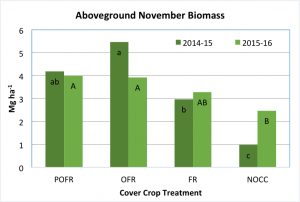 Figure 1. Aboveground cover crop biomass in November 2014 and 2015.
Figure 1. Aboveground cover crop biomass in November 2014 and 2015.
Using fall biomass (dry weight) and nitrogen concentration (%N), we estimated the amount of nitrogen recycled to the sweet corn from the fall cover crop biomass. Despite the fact that LW and POFR had higher concentrations of N by weight, OFR and POFR biomass contained more nitrogen in terms of weight per hectare (see Figure 2).
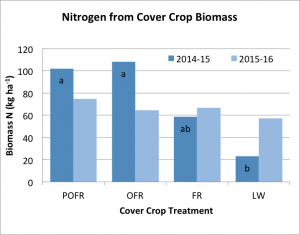 Figure 2. Nitrogen from fall cover crop biomass. This data is calculated from fall biomass and not from spring residue; some N is likely lost to spring nitrate leaching.
Figure 2. Nitrogen from fall cover crop biomass. This data is calculated from fall biomass and not from spring residue; some N is likely lost to spring nitrate leaching.
Cover crop mixtures did not significantly affect spring soil temperatures. There were significant differences by cover crop treatment only in 2014-15 during the two-week course of measuring temperature, but differences were less than 1 °C at the time sweet corn was planted. This indicates that these cover crop treatments will neither increase precocity or delay of timely seeding. We had hypothesized that the FR treatment might allow for earlier sweet corn planting compared with LW, but that was not the case.
Carbon to Nitrogen ratio (C:N ratio) was slightly increased in POFR and OFR compared with FR, although there were no significant differences found in year one of the research. C:N ratios ranged from 25:1 to 17:1, with the control plots (natural weed population) having the lowest ratio. Cover crop mixtures POFR and OFR averaged 22:1 and 23:1, respectively, which is precisely in the range for timely mineralization of N by microbial decomposition.
Soil nitrate taken in April, May, June and July was analyzed with the awareness that nitrate is highly variable depending on rainfall, soil temperature, and micro-topography. However, overall trends showed that FR treatments resulted in higher concentrations of soil nitrate in early spring, prior to sweet corn planting. This nitrate will have been lost to leaching or uptake by weeds. OFR and POFR showed significantly better synchronization with sweet corn demands, being highest in June when sweet corn is at peak growth. LW plots had significantly less available soil nitrate at all dates compared with cover crops. We interpret this to mean that OFR and POFR mixtures are better suited to no-till production systems than FR alone.
Pre-sidedress nitrate tests resulted in nitrate concentrations lower than the 21 ppm N threshold for all treatments. This indicates that combined mineralization from cover crop residue and soil organic matter did not supply sufficient N for the entire growing season; supplemental side-dress N fertilizer was required.
Sweet corn yields were higher in 2015 than in 2016, likely as a result of severe drought during the 2016 growing season (see Figure 3). However all treatments, except the control in 2016, exceeded the regional average of 35,500 ears per hectare.
| Marketable ears of sweet corn per hectare | 2015 | 2016 |
| POFR | 45029 | 40544 |
| OFR | 45208 | 38571 |
| FR | 48617 | 35162 |
| LW | 39109 | 33727 |
Figure 3. Sweet corn yield in ears per hectare, average across N fertilizer treatments.
In 2015, sweet corn yield was significantly affected by cover crop treatment (see Figure 4). FR treatment increased sweet corn yield by 22% compared with control plots. OFR and POFR treatment yields were 14% more than LW control plots. The trends were different in 2016, with POFR yielding the highest number of ears, however differences were not statistically significant.
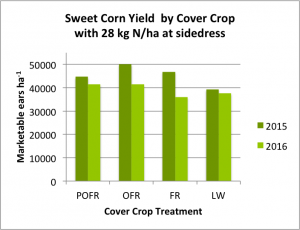 Figure 4. Sweet corn yield by cover crop treatment with 28 kg N/ha at sidedress. This level of N fertilizer was most efficient.
Figure 4. Sweet corn yield by cover crop treatment with 28 kg N/ha at sidedress. This level of N fertilizer was most efficient.
In 2016, sweet corn yield exhibited a significant quadratic response to N fertilizer treatment (see Figure 5). Sweet corn fertilized with either 28 kg N ha-1 produced 14% more than control plots that received no supplemental fertilizer. Plots that received 56 kg N ha-1 (split application) produced 11% more than control plots. All plots that received some supplemental N fertilizer exceeded the regional average of 35,500 ears per hectare. In both 2015 and 2016, the highest yielding treatment combination was OFR with 28 kg N ha-1. Sweet corn quality, evaluated by tip fill and ear length, was not affected by cover crop treatment or N fertilizer in either year.
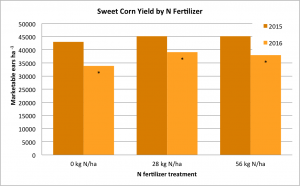 Figure 5. Sweet corn yield with N fertilizer treatments. A significant quadratic relationship was found in 2016.
Figure 5. Sweet corn yield with N fertilizer treatments. A significant quadratic relationship was found in 2016.
Experiment #2:
In year one of the weed experiment, plots were accidentally terminated in May so the only data collected was in November and April. In-season weed biomass was measured only in June 2016.
In November, just prior to winter-kill, the smallest weed biomass occurred in the FR plots, which was 193% less than the control (LW) plots. All weeds were winter-killed along with radish plants. In spring, new annual weed seeds germinated as temperatures warmed. Prior to sweet corn planting in late April, weed suppression was most successful in FR plots (14 g m-2), while POFR and OFR were similar (19.9 and 20.0 g m-2 respectively) (see Figure 6). Control plots had an average of 211 g m-2.
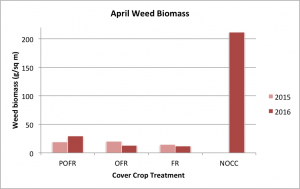 Figure 7. Spring weed biomass in April both years.
Figure 7. Spring weed biomass in April both years.
In June, sweet corn plants reached an average of 25 cm tall and plant nitrogen demand peaks. At this point in it’s life cycle, weed pressure significantly affects corn yield. While FR plots still had the lowest weed biomass by dry weight (72.6 g m-2), those plots also had the greatest number of weeds (32 plants) (see Figure 7). OFR plots had 72% less than FR and the least number of weeds per sample (15 plants), with a total of 82.8 g m-2 of dry weed biomass (see Figure 7). This reveals the germination effect caused by the nitrate flush of rapid FR decomposition on responsive weed species, such as lambsquarters (Chenopodium album) (Vincent and Roberts, 1977).
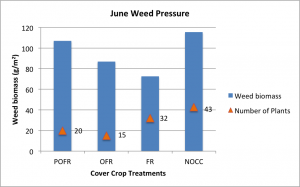 Figure 7. Weed biomass and number of plants in June 2016.
Figure 7. Weed biomass and number of plants in June 2016.
We postulate that oat residue had a lasting effect of reducing weed seed germination in spring. Plots that did not receive a pre-emergent herbicide (S-metolachlor) at corn planting were totally overtaken by weeds and did not yield any sweet corn. So while cover crops may provide effective early spring weed suppression, the effect is not enduring and is insufficient for sweet corn production.
Conclusion:
While these winter-killed cover crops did not increase the precocity of sweet corn, they did provide sufficient benefits to consider the no-till production system successful. Sweet corn yields following cover crop treatments exceeded regional averages and the weedy control. All sweet corn benefitted from a small application of supplemental fertilizer (28 kg N ha-1) at side-dress. However this reduced rate indicates the successful cycling of N by cover crops and is a significant reduction in total N fertilizer applied compared with recommended rates (140 kg N ha-1). Weed suppression by FR and OFR was effective in fall and early spring, and with a one-time application, at sweet corn planting, of glyphosate and S-metolachlor, weed control was effective through the main growing season. A twice-yearly herbicide application is a significant reduction compared to current spray practices.
The integration of no-till sweet corn production and low-residue winter-killed cover crop mixtures can provide economic and environmental benefits to increase sustainability for the Northeast.
The results of this research demonstrate how cover crop mixtures can provide economic and environmental benefits in vegetable production. By integrating winter-killed cover crop mixtures in sweet corn production systems, we can achieve greater resiliency over a range of fertility and weather circumstances.
The knowledge gained from these experiments can have a major impact in several ways. First, it shows the success of an integrated full-season production system for no-till sweet corn in New England. Second, this research indicates the feasibility of reducing nitrogen fertilizer applications at sweet corn planting, which will reduce nitrate leaching into groundwater. Third, reduced fertilizer requirements also save input and labor costs for farmers. No-till sweet corn production utilizing these types of winter cover crops could enhance sustainability over 12,000 acres of production in the Northeast.
Education & Outreach Activities and Participation Summary
Participation Summary:
From 2015 to 2017 I presented my research at a number of events and through several publications (see list concluding this section). In February 2017 I shared my results at the University of Maine Cooperative Extension In-Service Training for Agricultural Service Providers in Portsmouth, NH. Forty participants included cooperative extension staff, University professors, NRCS staff, and agricultural consultants.
On January 4, 2017 I won first place in the graduate student oral presentation competition (Crop and Soils division) at the Northeastern Plant, Pest, and Soils Conference in Philadelphia, PA. My research poster won first place in it’s division at the same conference in 2016 (see attachment). I spoke to many people over the course of these conferences about my research and have followed up with personal communication and sharing data.
The UMass Cover Crop Tour at the NOFA Summer conference in July 2016 allowed me to share my research and initial results with nearly 30 farmers and agricultural service providers. The UMass Agricultural Field Day provided an opportunity to present initial data to 120 participants that included farmers and educators. Two articles published in the UMass extension newsletter were sent to thousands of growers.
Presentations & Publications:
|
“Cover Crop Mixtures for Sustainable No-Till Sweet Corn in the Northeast.” (poster) School of Earth and Sustainability Inauguration, UMass Amherst. Amherst, MA |
April 17, 2017 |
|
“Winter-killed Cover Crop Mixtures for Sustainable No-Till Sweet Corn Production.” (poster) UVM Extension No-Till Cover Crop Symposium. So. Burlington, VT |
Feb 16, 2017 |
|
“Integrating Cover Crop Mixtures and No-Till for Soil Health and Sustainable Sweet Corn Production.” In-Service Training for Agricultural Service Providers. University of Maine Cooperative Extension. Portsmouth, NH |
Feb 2, 2017 |
|
“Cover Crop Mixtures for Soil Health.” Northeast Organic Farming Association (NOFA) Winter Conference Session. Worcester, MA |
Jan 14, 2017 |
|
“Integrating No-till and Cover Crop Mixtures for Sustainable Sweet Corn Production in the Northeast.” Graduate Student Oral Competition, Agronomy and Soils Division. Northeastern Plant, Pest, and Soils Conference. Philadelphia, PA |
Jan 4, 2017 |
|
“Cover Crop Mixtures for Sustainable No-Till Sweet Corn Production.” (poster) Graduate Student Poster Competition, Agronomy and Soils Division. Northeastern Plant, Pest, and Soils Conference. Philadelphia, PA |
Jan 3, 2016
|
|
Girls Inc. Eureka! STEM Program. Volunteer teaching teen girls agricultural science, field research, and hands-on experiments. S. Deerfield, MA |
July 2015 July 2016 |
|
“Cover Crop Mixtures for Sustainable No-Till Sweet Corn Production.” (poster) UMass Amherst Plant Biology Symposium. Amherst, MA |
Oct 2015 and Oct 2016 |
|
UMass Agricultural Field Day. Presented methods and results of two experiments to 120 farmers and agricultural service providers. Amherst, MA |
June 2015
|
|
Farming with Nature: Improving Soil Health on Vegetable Farms. Presented at two NRCS Soil Health Workshop with Ray Archuleta. Amherst & Dighton, MA |
Nov 3 & 4, 2014
|
Extension Publications
|
Fine, JS. “Low-residue Cover Crop Mixtures for Spring Fertility and Weed Control.” UMass Extension Vegetable Notes. Vol. 27, No. 18. Aug 2015. |
|
Fine, JS. “Integrating Cover Crop Mixtures with No-Till Sweet Corn Production.” UMass Extension Crops, Dairy, Livestock and Equine Newsletter. Vol. 18, No. 2. Summer 2015. |
Project Outcomes
The results of this research point to the ability of cover crops to reduce both cost to farmers and environmental costs, if properly designed and managed. The cost of cover crop seed ranged from $72 to $21 per acre, not including fuel and labor (seed Figure 8).
|
Cover crop species |
Seeding rate: drilled (lbs/ac) |
Seed price ($/lb) |
Seed cost ($/ac) |
|
Forage radish (FR) |
7 |
$3.00 |
$21 |
|
Oat/FR (OFR) |
50/3 |
$0.40/ $3.00 |
$29 |
|
Pea/Oat/FR (POFR) |
45/30/2 |
$1.20/ $0.40/ $3.00 |
$72 |
Figure 8: Seed costs for cover crop treatments, based on local prices in August 2015.
Using fall biomass (dry weight) and nitrogen concentration (%N), we estimated the amount of nitrogen recycled to the sweet corn from the fall cover crop biomass. It is assumed that control plots with natural weed populations over winter will require the full rate of N fertilizer. Although there is no cost to a winter fallow of weeds, the full rate of fertilizer must be applied to reach N sufficiency of 125 lbs ac-1 (see Figure 6). This weedy fallow is just as costly as the most expensive cover crop treatment, POFR, and does not provide as many ecosystem services. The most cost effective cover crop treatment in terms of nitrogen, is the FR treatment followed closely by OFR. When the other benefits of cover crop treatments are taken into account, such as cover crop biomass and weed biomass, it may be that OFR is the most economically viable cover crop in this no-till sweet corn production system.
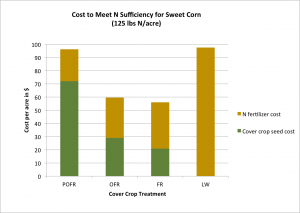 Figure 9: Cost to meet nitrogen sufficiency by cover crop treatment
Figure 9: Cost to meet nitrogen sufficiency by cover crop treatment
Farmer Adoption
I have met with a number of extension educators and conservationists at NRCS, UMass, UVM, UMaine and UNH, all of whom were interested in the results of this research. The challenge has been to connect with no-till sweet corn farmers directly. The few farmers I spoke with were enthusiastic about the experiment and results. They described how planting these cover crop mixtures early enough in the fall could be a challenge, if the preceding crop was still in the field until late September or later. After presenting at the UMaine Extension In-Service Training, a NRCS district conservationist wanted to discuss the possibility of sharing this research with no-till sweet corn farmers in New Hampshire. I look forward to the opportunity to directly connect with farmers at the December 2017 Northeast Vegetable and Fruit Conference.